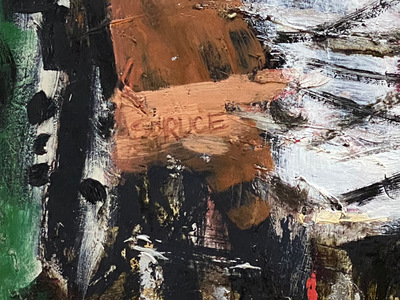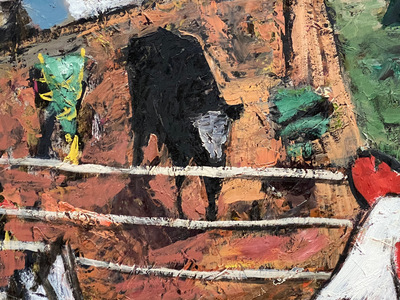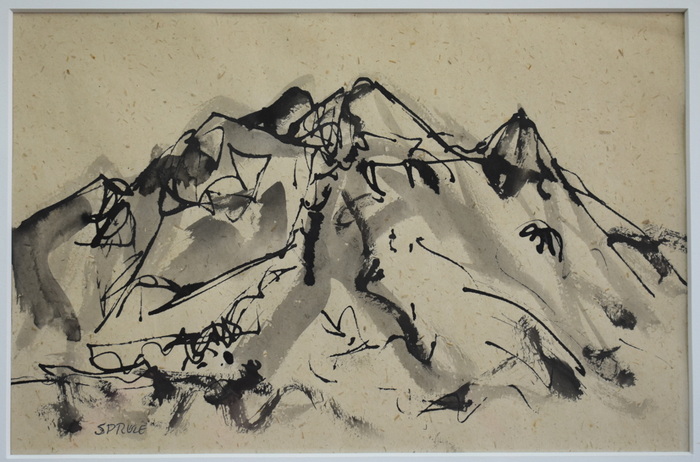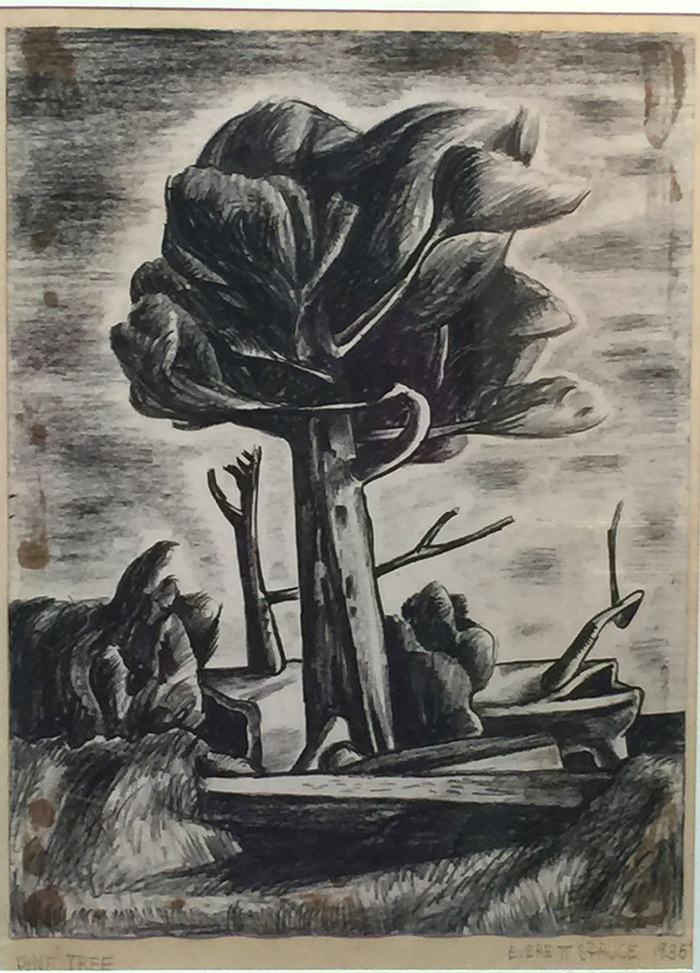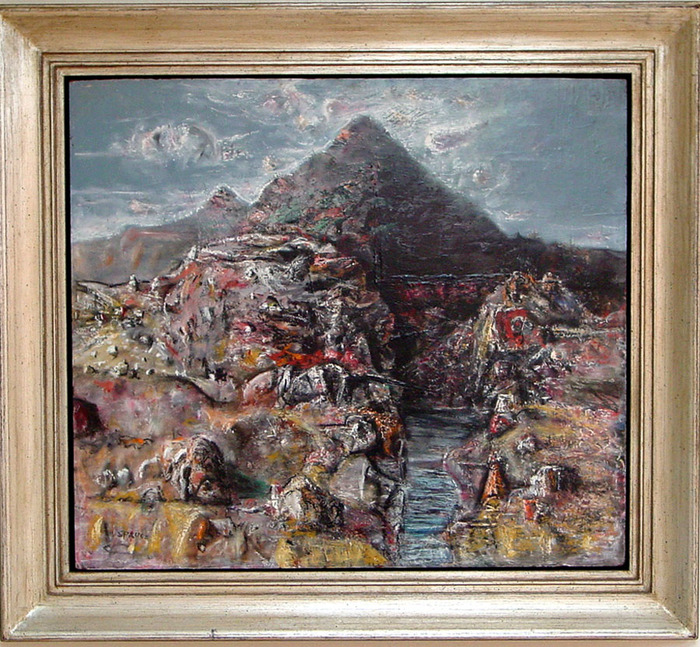Everett Spruce "Barnyard"
-
- Everett Spruce
- (1908 - 2002)
- Austin Artist
- Image Size: 20 x 24
- Frame Size: 26 x 30
- Medium: Oil
- Circa 1940s
- "Barnyard"
- Contact for Price & Info
- View All By This Artist
Details
Mid Century Modern
-
-
Biography
Everett Spruce (1908 - 2002)
 Everett Franklin Spruce (1907–2002)
Everett Franklin Spruce (1907–2002)
Everett Franklin Spruce was an artist and teacher who grew up in Arkansas and worked in the state periodically in the 1920s and 1930s. Spruce is considered the most prominent painter to emerge from a group of Texas regionalists in the 1930s. He was highly influenced by his boyhood in the Ozarks, and his paintings always reflected his love of the land and of nature.
Everett Spruce was born in Holland, (Faulkner Country), on December 25, 1907 (some references list 1908). He was the first of six children born to William Everett Spruce and Fanny May (McCarty) Spruce. His father, who was of Irish descent, was a farmer.
In 1911, the Spruce family moved to Adams Mountain in rural Pope County. Spruce’s father raised apples and peaches as his cash crops atop the mountain. Spruce’s interest in art began as a boy, and he enjoyed drawing. Later, the family moved just north of Mulberry, (Crawford County.), where they raised cotton and corn. In 1925, Spruce graduated from Mulberry High School.
As Spruce grew older, he continued to sketch and started painting with watercolors, although without formal training. In about 1925, his aunt told a family friend, Maud Hail, of her nephew’s artistic talent. Hail told her daughter and son-in-law, the Texas-based artist couple Kathryne and Olin Travis. On their next trip to the Ozarks, Olin Travis sent for Spruce, who brought some sketches for review. Travis encouraged Spruce in his artistic endeavors and, in 1926, offered him a scholarship to the newly formed Dallas Art Institute (DAI).
Despite his father’s disapproval, Spruce enrolled at the DAI, where he studied under Olin Travis and Thomas Stell. While studying at the DAI (1926–1929), Spruce lived in the basement, worked as a janitor, and taught classes for children.
During his residency at the DAI, Spruce met Alice Virginia Kramer, a Dallasite of German descent. They exhibited together in Dallas occasionally and, in 1927 and 1928, went to Arkansas to participate in the Travis Ozark Summer Art School held in Cass (Franklin County). Spruce and Kramer were married in Dallas on February 18, 1934; they had twin daughters and two sons.
In 1931, Spruce took a position with the Dallas Museum of Fine Arts (DMFA) as a gallery assistant. He worked during the day and painted nights and weekends. He was promoted to registrar in 1936, and then to assistant director, before leaving the DMFA in 1940.
In 1932, Spruce was included in a select group of Texas artists as part of the “Exhibition of Nine Artists Under the Age of Thirty” at the Dallas Public Art Gallery. After this exhibition, Spruce was grouped with several other Dallas regionalists known as the “Dallas Nine,” including Alexandre Hogue and Jerry Bywaters. He began to exhibit his work across the country. In 1936, his painting Ozark Mountaineer was accepted for inclusion in the Annual Exhibition of American Paintings and Sculpture by the Art Institute of Chicago. From 1936 until 1939, his paintings were selected for eleven different exhibitions across the United States, including one-man shows at galleries in New York in 1937 and 1938. In 1939, his painting The Hawk was acquired by the Museum of Modern Art in New York.
In 1940, Spruce accepted a position as instructor in life drawing and creative design at the University of Texas at Austin. He became a full professor and, from 1949 to 1951, served as chairman of the art department. He retired as professor emeritus in 1974.
Spruce continued to exhibit his paintings throughout the 1940s and 1950s. A retrospective of his work was held at the DMFA in 1958, and, in 1959, a traveling exhibition of his art funded by the Ford Foundation toured much of the United States, including stops in three Arkansas cities: Fort Smith (Sebastian County.), Batesville (Independence County.), and Fayetteville (Washington County.), In 1958, he was also honored with the first portfolio of the Blaffer Series on Texas Art. He exhibited less frequently in the 1960s and especially the 1970s, when he spent time caring for his ailing wife, but his output increased in the 1980s and 1990s.
Although many of his early paintings were based on scenes in the Ozarks, for the majority of his career, Spruce concentrated on the landscape of his adopted state of Texas. He worked primarily in the Hill Country, Big Bend Area, Gulf Coast, and West Texas. He primarily used a style known as expressionism. As an expressionist, he sought to capture not an exact likeness of his subject but rather to evoke his feelings in response to a specific scene. He also incorporated elements of cubism and surrealism in some works and experimented briefly with nonobjective abstraction. Spruce’s early work was about form, and later work focused more on color.
Some of his other well-known paintings include Mending Rock Fence (1936), West Texas Incident (1937), Arkansas Landscape, Afternoon (1938), Twins (1939), Big Bend (1945), Autumn Landscape (1955), Rio Grande (1958), and Prairie Night, Goat Pasture (1972). His work is part of the permanent collection of over thirty museums and public collections, including the Museum of Modern Art in New York and the Whitney Museum of American Art in New York.
Spruce died on October 18, 2002. He is buried at Austin Memorial Park in Austin, Texas.
For additional information:
Carraro, Francine. Companions in Time: The Paintings of William Lester and Everett Spruce. Austin, TX: Laguna Gloria Art Museum, 1993.
Everett Spruce Collection. Bywaters Special Collections. Hamon Arts Library. Southern Methodist University, Dallas, Texas.
Powers, John, and Deborah Powers. Texas Artists, Sculptures, and Graphic Artists. Austin, TX: Woodmont Books, 2000.
Stewart, Rick. Lone Star Regionalism: The Dallas Nine and Their Circle, 1928–1945. Austin, TX: Texas Monthly Press, 1985.
W. Russ Aikman
The following, submitted by a researcher of the Ashworth Collection of Native American and Western Art, is from the artist's obituary in the Fort Smith, Arkansas "Times Record" newspaper, October 20, 2002. Everett F. Spruce, well-known artist, teacher, professor emeritus, died Friday, Oct. 18, 2002, at age 94. Everett Spruce was born on a farm in Conway to William E. and Fannie McCarty Spruce. He came to Dallas, at age 17, on a scholarship to study at the Dallas Art Institute, under Olin Travis and Thomas M. Stell Jr. In 1931, he became gallery assistant at the Dallas Museum of Fine Arts and in 1934 married Alice V. Kramer, a fellow art student. He was one of the "Dallas Nine" group of Southwest artists. By the time he joined the art faculty of the University of Texas at Austin in 1940, he had achieved national recognition, and his work has been chosen for inclusion in major national juried exhibitions. He served as chairman of the Department of Art at the University of Texas at Austin 1949-51, became professor of art in 1954 and served as director of Graduate Studio Art 1961-74. He retired in 1974 as professor emeritus and was recognized as one of the outstanding painters in Texas. His work was exhibited nationally and internationally, including Texas Centennial Exhibition Dallas, Museum of Fine Arts, annual exhibition of Contemporary American Paintings, Whitney Museum of American Art New York, annual exhibition of American Painting and Sculpture, Art Institute Chicago, exhibition of American Painting and Sculpture, Carnegie Institute Pittsburg, "A Particular Portion of Earth" Pan American Union Washington, D.C. Upon his retirement from the University of Texas, he was honored with a Retrospective Exhibit, Selected Paintings and Drawings, 1950 to 1979. In 1993, he was honored with an exhibition "Companions in Time: The paintings of William Lester and Everett Spruce" by Laguna Gloria Art Museum. Mr. Spruce won numerous prizes including Purchase Prize "Painting of the Year" Pepsi-Cola Competition, National Academy of Design New York, Scheidt Memorial Prize, 142nd annual exhibition Pennsylvania Academy of Fine Arts, First Prize Exhibition of Modern American Paintings, Galerie Giroux Brussels and was chosen as the first artist to be represented in the Blaffer Series of Southwestern Art, published by the University of Texas Press. He was awarded a Ford Foundation Grant Retrospective Exhibition circulated by the American Federation of Arts, South, Midwest and West. His work is highlighted in many publications including "Lone Star Regionalism, the Dallas Nine and Their Circle", by Rick Stewart published by Texas Monthly Press; "Pecos to Rio Grande, Interpretations of Far West Texas by Eighteen Artists", published by Texas A&M University Press; "The Texas Gulf Coast, Interpretations by Nine Artists", published by Texas A&M University Press and "Art for History's Sake, The Texas Collection of the Witte Museum" by Cecilia Steinfeldt published by the Texas State Historical Association. In addition, he was honored for his lasting contributions to the art world and for his exemplary work as an educator by a resolution bestowed by the Texas House of Representatives and signed by the then Gov. George W. Bush. In addition to pieces held by numerous private collections, his works are included in many public collections including Metropolitan Museum of Art New York, Dallas Museum of Fine Art, M.H. DeYoung Museum San Francisco, Fort Worth Museum, Museum of Fine Arts Houston, Marion Kugler McNay Art Institute San Antonio, Museum de Arte Moderno Rio De Janeiro, Museum of Modern Art New York, Phillips Gallery Washington, D.C., Southern Methodist University Dallas, Tulane University New Orleans, University of Alabama, University of Nebraska, University of Texas at Austin, Whitney Museum of American Art New York and Witte Memorial Museum San Antonio. Mr. Spruce continued to paint and exhibit into his 88th year. He included a sense of music and poetry in his painting. In many instances he could identify the exact spot he translated into paint, describing the time of day, the weather, the light and where he stood when he viewed it. His paintings are rich in color, texture and mood, communicating strength and substance. He was an amazingly productive artist, painting mostly landscapes, though he occasionally painted fascinating people, birds and animals. Mr. Spruce especially loved trees, of which he said, "each has its own personality." In addition, he appreciated nature, particularly mountains, cactus, birds, animals, the ocean, rocks, craggy countryside, the sky and storms. He treasured anything Celtic/Irish, was fascinated by languages and different cultures, enjoyed good music, Yeats, Thomas Hardy, William Faulkner and all good literature. Teaching was his forte and many former students kept in touch throughout his long lifetime.

